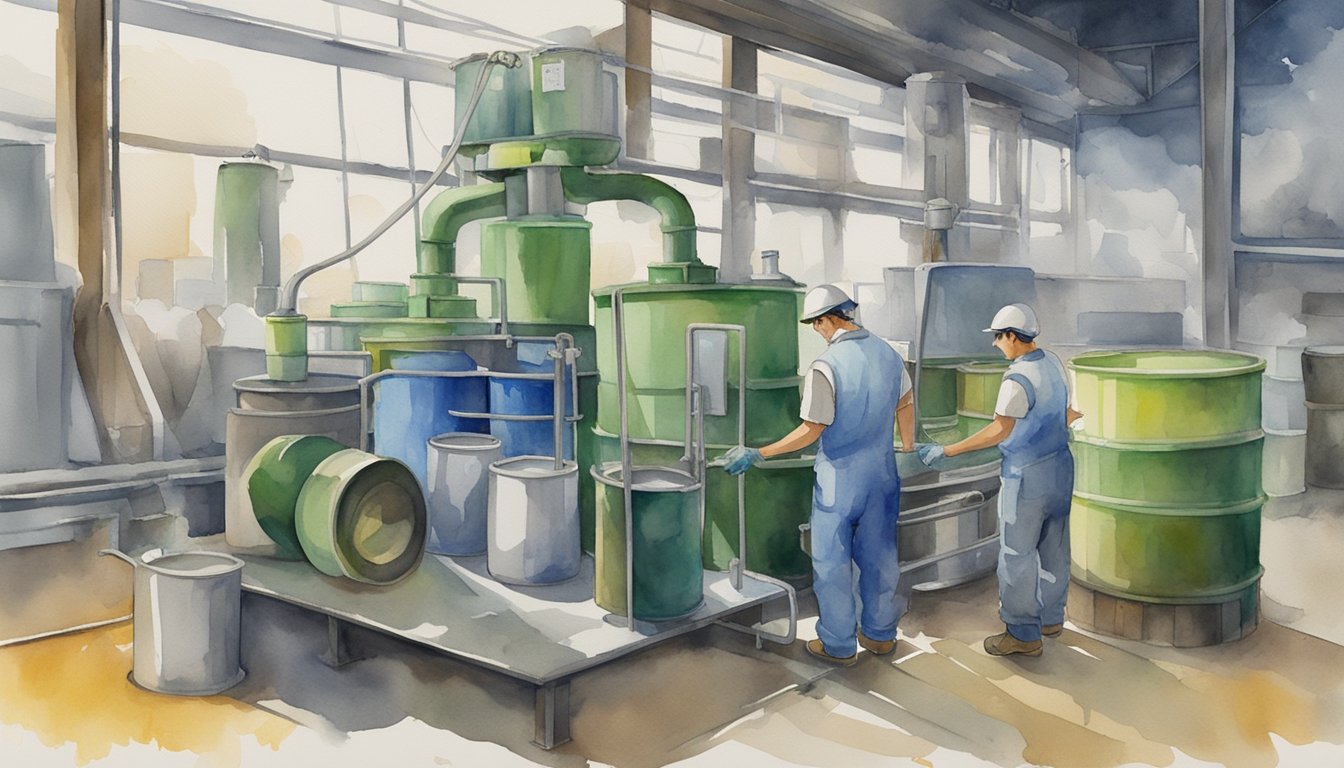Exploring the intricate dynamics between solvents and dissolved analytes reveals a captivating aspect of chemistry that affects a variety of fields, from everyday laboratories to industrial settings. Solvent and analyte chemical properties significantly influence interactions during chemical reactions and separations, often determining the efficiency and success of these processes. By understanding these interactions, you can enhance the precision and effectiveness of your analytical techniques.
Different solvents and analyte compounds bring unique attributes to the table, such as polarity, viscosity, and chemical reactivity, which all play critical roles in analyte behavior and solution dynamics. These properties dictate the interactions between solvent molecules and analytes, impacting the separation, detection, and overall performance of analytical processes. Choosing the right solvent for the analyte of interest is crucial, as it directly influences factors such as solute-solvent interaction strength, reaction kinetics, and safety profiles in laboratory environments. By aligning solvent selection with specific analytical goals and safety requirements, you can optimize both efficiency and safety.
Solvent–Solute Interactions
Understanding how solvents and solutes interact provides a foundation for predicting solubility, guiding reaction conditions, and designing separation methods. These interactions are governed by the inherent properties of both the solvent and solute, as well as the intermolecular forces that arise between them. Each solvent exhibits unique characteristics based on molecular structure—such as polarity, hydrogen-bonding capacity, and dielectric constant. These attributes determine how a solvent interacts with solutes of different chemical compositions. Selecting a solvent based on these chemical characteristics supports better control over solubility and system behavior during analytical or preparative procedures.
For instance, ionic compounds are often well-suited to polar solvents due to strong ion–dipole attractions. Water, with its high polarity and hydrogen-bonding ability, can solvate ions effectively. It surrounds charged species like sodium and chloride, stabilizing them in solution and preventing their recombination. In contrast, non-polar solvents such as hexane offer limited solvation for ions but are more suitable for dissolving non-polar molecules through dispersion forces.
Solvent and Solute Molecular Behavior
Interactions between solvent and solute molecules affect not only solubility but also the outcome of chemical processes. Depending on the molecular structures of the solvent and solute, these molecules can engage in diverse electrostatic interactions, such as hydrogen bonding and dipole interactions, London dispersion forces, or hydrophobic effects.
For example, when sodium chloride dissolves in water, ion–dipole forces allow water molecules to orient around each ion. This results in a hydration shell that stabilizes the ionic species. Hydrogen bonding between surrounding water molecules further supports solution stability, allowing for uniform dispersion of solute ions.Recognizing these interaction types helps predict how specific solutes will behave in various solvents, which is relevant across both research and manufacturing environments.
Dynamics of Solvent-Solute Interactions
The dissolution process involves a shift in the balance of interactions. Initially, solute–solute and solvent–solvent forces dominate. As the solute enters the solvent, these are replaced by solute–solvent interactions, forming a new thermodynamic equilibrium.
For ionic compounds, the transition to solute–solvent interactions often drives dissolution. Dipole–dipole attractions, hydrogen bonds, and van der Waals forces all contribute to the final state of the solution. These dynamics influence not only solubility but also reactivity, phase distribution, and thermodynamic stability—factors that carry implications in drug formulation, purification, and product development.
Influence of Solvent Polarity
Polarity is a fundamental property that shapes how solvents interact with analytes during chemical analysis and separation. By evaluating the polarity of both solvent and analyte, one can anticipate changes in retention time, peak shape, and solubility.
Polar vs. Non-polar Solvent Effects
Polar solvents, such as water and methanol, possess high dielectric constants and substantial dipole moments. These features allow them to reduce electrostatic attractions between charged species and form dipole-based interactions with analytes. Such behavior influences analyte partitioning, particularly in chromatographic systems where polarity drives differential retention. They can induce solvatochromic effects, causing shifts in absorption peaks for certain compounds. For example, non-bonding lone pairs on analytes like amines may result in hypsochromic shifts or blue shifts with polar compounds due to ground-state stabilization.
Non-polar solvents, including alkanes like hexane, interact primarily through dispersion forces. These solvents show limited compatibility with polar or ionic solutes, often resulting in low solubility. This selective solubility can benefit techniques like liquid–liquid extraction, where non-polar analytes migrate toward the organic phase, facilitating separation.
Protic and Aprotic Solvents
The distinction between protic and aprotic polar solvents further refines our understanding of solvent interactions. Protic solvents, such as water and ethanol, possess hydrogen bond donors and can form hydrogen bonds with analytes. This capability enhances their interaction with polar and ionic substances, promoting solubility and efficient separation.
Aprotic polar solvents, such as acetone and dimethyl sulfoxide, lack hydrogen bond donors but can still possess a significant dipole moment. These solvents can have varying degrees of solubility for polar, ionic, and organic compounds, making them versatile in analytical and preparative chemistry.
The solvent system chosen for an analytical method must match the physical and chemical behavior of the analyte. In chromatography, for example, solvent polarity directly influences analyte retention, resolution, and detection response.
Chemical Reactivity and Solvent Selection
The right solvent can affect the rate of reaction, the stability of the transition state, and the overall success of chemical transformations, so understanding how solvents influence chemical reactivity is an essential step in choosing the right solvent for specific reactions.
Influence of Solvents on Reaction Pathways
In organic synthesis and other chemical processes, solvents act as the environment in which molecular interactions occur. They can stabilize or destabilize charged or polar transition states, shift equilibria, and impact activation energy.
Polar solvents, especially those with high dielectric constants, are often effective at stabilizing polar intermediates and transition states, which can lead to increased reaction rates. In contrast, non-polar solvents may be better suited for reactions involving non-polar substrates or mechanisms driven by dispersion forces. The degree of solvent–solute interaction can alter how reactants approach each other, influencing the course and yield of a reaction.
Selecting the Right Solvent for Reaction Efficiency
Choosing an appropriate solvent for a chemical reaction involves balancing several factors, including polarity, dielectric constant, and chemical inertness. A compatible solvent should not participate in the reaction or interfere with the reactivity of the compounds involved.
Solvent selection tools and data tables provide guidance by outlining physical properties such as boiling point, miscibility, and reactivity profiles. These references can help identify solvents that match the intended reaction conditions without introducing unwanted variables.
Different reactions may favor different environments, so matching solvent characteristics with the desired transformation pathway allows for more predictable outcomes and improved reproducibility. This approach supports method development in both research and manufacturing settings.
Physical Properties of Solvents
Analyzing the physical properties of solvents is a fundamental step in selecting an appropriate medium for chemical analysis. These characteristics influence solute compatibility, method performance, and reproducibility. Parameters such as boiling point, viscosity, solubility behavior, and cohesive energy provide a detailed profile of how a solvent behaves under specific conditions.
Boiling Point and Viscosity
The boiling point of a solvent determines the temperature at which it transitions from liquid to gas. Solvents with high boiling points typically have strong intermolecular attractions, which can influence their solubility properties and suitability for specific applications.
Viscosity is another important property, describing a fluid's resistance to flow. Low-viscosity solvents, such as ethanol, enable faster diffusion and improved mixing, which can enhance efficiency in applications like sample preparation, extractions, or chromatographic separations. However, low viscosity indicates weaker intermolecular forces. Choosing a solvent with an appropriate boiling point and viscosity is essential for tailoring the analytical process to your specific requirements.
Solubility Parameters and Cohesive Energy
Solubility parameters help predict solvent and solute compatibility. Hansen solubility parameters categorize these interactions into dispersion, polar, and hydrogen bonding forces. Solvents with high or intermediate polarity show greater interactions with similar analytes. By using solubility parameters, you can select solvents that best match your analyte's properties, optimizing solubility and efficiency in separation processes.
Cohesive energy measures the total strength of intermolecular forces within a solvent. Solvents with high cohesive energy, such as water, exhibit strong intermolecular attractions, which can favor the dissolution of solutes with similar intermolecular forces but may hinder the solubility of nonpolar solutes. Understanding cohesive energy helps guide solvent selection, particularly when predicting compatibility with solutes in chemical analyses.
Solvent Effects in Different Phases
Solvent properties influence analyte behavior across various phases—including gas, liquid, solid, and membrane systems. Characteristics such as polarity, hydrogen-bonding capacity, and volatility contribute to how analytes interact within and between phases, shaping outcomes in separation, retention, and transport.
Impacts on Gas and Liquid Phases
In gas chromatography, the retention behavior of analytes is shaped by their interactions with both the stationary phase and the carrier gas. Analyte volatility, molecular polarity, and surface affinity all affect separation efficiency. Choosing an appropriate stationary phase and carrier gas helps refine parameters such as resolution and peak symmetry.
In liquid chromatography, solvent choice affects retention time, selectivity, and analyte distribution between the mobile and stationary phases. For example, in reversed-phase liquid chromatography (RPLC), methanol can be used to adjust the polarity of the mobile phase. Its polar characteristics support solubility for polar analytes, while its hydrophobic components reduce retention for less polar compounds.
This balance of polar and non-polar interactions allows methanol to modulate retention patterns in compounds like biphenyl, enabling more refined separations. Adjusting solvent strength and composition in this way helps match mobile phase behavior with the chemical nature of target analytes.
Behavior in Solid Phase and Membrane Systems
In solid–liquid equilibrium processes, solvent properties such as polarity and hydrogen-bonding behavior influence solubility and phase distribution. These effects play a role in phase separation and impact how efficiently a solute migrates between phases under static or dynamic conditions.
Membrane-based systems depend on interactions between the analyte, the solvent, and the membrane material itself. Solvent compatibility with the membrane influences analyte diffusion, swelling behavior, and overall system permeability. For example, in liquid-phase membrane separations, solvent polarity can impact transport rates and selective permeability by altering membrane structure or solvent–solute interactions.
Solvent selection in these systems is often guided by desired analyte behavior—whether promoting or limiting permeability—making physical compatibility and molecular interaction profiles central to process design.
Solvent Use in Analytical Chemistry
Solvent selection in analytical chemistry plays a major role in the effectiveness of techniques such as mass spectrometry and chromatography. The physical and chemical properties of solvents influence analyte behavior, ionization efficiency, and separation quality. In addition, solvent purity directly affects data reliability by minimizing background noise and contamination.
Mass Spectrometry and Chromatography Considerations
In mass spectrometry, solvent characteristics impact ionization behavior, evaporation rate, and compatibility with the ion source. Volatile solvents like methanol and acetonitrile are widely used in electrospray ionization (ESI) due to their ability to support rapid droplet desolvation and stable spray formation. These conditions contribute to stronger signal output and improved detection of low-abundance analytes.
Proper solvent selection also helps manage ion suppression and matrix effects, which can otherwise reduce measurement accuracy. Matching solvent volatility and polarity to the needs of the ion source contributes to more consistent analytical performance.
In liquid chromatography, the solvent composition of the mobile phase determines analyte partitioning between phases. Reversed-phase chromatography, for example, pairs a nonpolar stationary phase with polar solvents like water. Organic modifiers such as methanol or acetonitrile are added to adjust the polarity of the mobile phase, which influences how strongly nonpolar analytes interact with the stationary surface.
By modifying the ratio of aqueous to organic solvent, analysts can fine-tune retention times, separation selectivity, and peak resolution according to method requirements.
Sample Preparation and Solvent Purity
Sample preparation directly affects the outcome of any analytical method, and solvent purity is a major factor in minimizing contamination. Trace impurities in solvents can interfere with analyte detection, introduce background signals, or disrupt retention patterns. Using high-purity solvents helps reduce the likelihood of introducing unwanted compounds, which supports cleaner baselines and improved reproducibility.
Blending different organic solvents allows for adjustment of properties such as elution strength, viscosity, and polarity. This flexibility is especially useful in optimizing methods for complex samples, where a single solvent may not meet all analytical requirements. Maintaining solvent quality and selecting appropriate combinations can support method consistency and facilitate more accurate interpretation of results.
Environmental and Safety Aspects of Solvents
When dealing with solvents, it is important to consider both their environmental impact and safety precautions. Understanding these aspects ensures responsible use, minimizing harm to both the environment and personal health.
Managing Environmental Hazards
Solvents such as ethyl acetate and ethylene glycol are common in various applications but may pose environmental hazards. These compounds can contribute to air and water pollution when not managed properly. Ethyl acetate is volatile and can evaporate quickly, potentially affecting air quality.
To reduce environmental impact, green chemistry principles recommend the selection of solvents with lower toxicity profiles and improved biodegradability. Sourcing solvents from renewable feedstocks or low-impact synthetic pathways can further support sustainability objectives.
Organizations, including the Journal of Chemical and Pharmaceutical Sciences, promote the use of less toxic solvents and urge the treatment of solvent waste to prevent local contamination. Approaches like recycling and purifying spent solvents can further support these efforts.
Safe Practices for Solvent Handling
Safe handling procedures are a core aspect of laboratory and industrial operations involving solvents. Even relatively low-toxicity solvents, such as dimethyl sulfoxide (DMSO), require caution due to properties like rapid skin absorption.
Use of personal protective equipment (PPE)—including chemical-resistant gloves, goggles, closed footwear, and lab attire—helps reduce direct contact and inhalation risk during solvent use. Adequate ventilation, such as fume hoods or exhaust systems, is recommended to manage airborne solvent vapors.
Proper storage also plays an active role in maintaining a safe workspace. Solvents should be kept in tightly sealed, clearly labeled containers, stored in temperature-controlled areas away from ignition sources. Spill response materials, such as absorbent pads and containment kits, should be readily accessible in case of accidental release.
Adhering to these safety measures supports consistent compliance with lab protocols and reduces the likelihood of hazardous exposure or environmental release.
Conclusions on Solvent–Analyte Interactions
A thorough understanding of solvent–analyte interactions supports method development across a range of analytical applications. Solvent choice influences how analytes behave in solution, affecting parameters such as solubility, retention, and detection. These effects are governed by the chemical characteristics of both the solvent and the analyte, as well as their compatibility under specific conditions.
Some solvents are chemically reactive, which may lead to side reactions or analyte degradation. In contrast, inert solvents are less likely to alter analyte structure or interfere with target compounds. Evaluating reactivity is a necessary step in selecting an appropriate solvent for reliable analysis.
In liquid-phase systems, analyte–solvent interactions form a dynamic equilibrium that affects solubility, phase partitioning, and surface adsorption. This equilibrium is influenced by external factors such as temperature, pressure, and solute concentration. Shifts in these conditions can impact analyte behavior, particularly in systems like chromatography, where retention and separation depend on fine-tuned interactions.
Solvents differ widely in their physical and chemical profiles. Polarity and hydrogen-bonding capacity influence how well they interact with different analytes. For polar compounds, polar solvents typically provide better solvation, while non-polar analytes often require less polar or non-polar solvents to maintain adequate solubility and system compatibility.
Recognizing and applying these solvent attributes allows for more precise control over analytical performance. Adjusting solvent systems based on analyte behavior supports consistent recovery, reproducibility, and method alignment with analytical objectives.
Key Takeaways
-
Solvent–analyte interactions are shaped by molecular structure, polarity, and reactivity.
-
Solvent choice influences both chemical reactivity and phase-based separation.
-
A well-matched solvent system supports reliable analyte behavior across analytical methods.
References:
-
https://www.birchbiotech.com/blogs/resources/ensuring-product-safety-with-residual-solvent-testing
-
https://jchps.com/specialissues/Special%20issue3/06%20jchps%20si3%20nanni%2049-52.pdf
-
https://molnar-institute.com/fileadmin/user_upload/_2017_Ramos_Chapter13.pdf
-
https://www.restek.com/articles/effect-of-organic-solvent-on-selectivity-in-LC-separations/
-
https://www.sciencedirect.com/science/article/abs/pii/S0167732222015124













